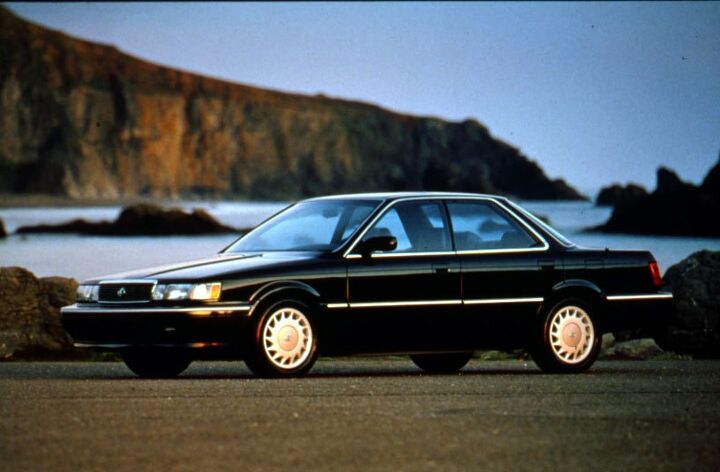Rare Rides: A Very Luxurious Camry, the 1990 Lexus ES 250

Today’s Rare Ride was the only other car accompanying Lexus’ LS 400 at dealerships in 1990 and 1991. The fanciest Camry offered in the US, it was a badge conversion from a Camry sold in the Japanese market.
But consumers saw through the charade, so while the high-effort LS 400 flew off the showroom floor, the minimal effort ES just sat there.
Much like the ES as it exists today, the first (V20-based) ES 250 was front-drive, had a V6 engine, and was designed for a two-lane comfort cruise. As Toyota approached its launch date for the flagship LS, they realized it wouldn’t be a great look to sell a singular vehicle under its highly anticipated and all-new brand.
The answer came from the Japanese market V20 Camry, which was launched in Japan late in 1986 for the ’87 model year. The V20 was a Camry of quality that was built domestically in Kentucky and established the nameplate in the US market. Camry would then take off with the now-legendary 1992 XV10 redesign.
While the V20 was sold in its sedan and wagon variants in North America, one body style was withheld: a frameless window pillared hardtop. Known as the Vista or Camry Prominent (after 1989), the luxurious Camry edit wore entirely different body panels to its sedan counterpart even though it looked almost identical. The Vista was a whole inch lower for a more sleek appearance, which meant it had notably less headroom than the cheaper sedan upon which it was based. Vista was never meant for export markets and was the official replacement for the prior generation’s five-door body style.
“This will have to do though,” said Lexus management. So the Vista became the ES 250 and was coded VZV21. The interior and exterior were quickly given a Lexus once-over. Outside, the ES grew a larger grille and tail lamps, additional chrome trim, and LS-adjacent wheels. All first-gen ES 250s had a suitably upscale two-tone paint scheme. The Vista’s interior was transformed via genuine wood appliques, ruched leather (usually), and lots of beige materials. ABS, airbag, a power sunroof, and CD player were standard. All ES 250s used the same 2.5-liter V6 from the Camry, though consumers had a choice in transmissions (wow!), and selected from a five-speed manual or four-speed automatic.
Lexus marketed the ES as “the luxury sedan of sports sedans,” which didn’t really hold up given its 159-horsepower engine, and very soft everything else. Customers weren’t too intrigued by a 1990 price tag of $22,000 ($47,803 adjusted) and saw it for what it was: a stop-gap until a real ES could be developed. Thus the ES remained in its first generation for only 1990 and 1991 before it was replaced by the much more successful XV10-based ES 300. Lexus sold less than 40,000 Es250s over those two years.
And that makes today’s Rare Ride a particularly unusual find. Beyond its low 38,000 miles traveled, it pairs a blue cloth (!) interior with a white and beige exterior. Your author has never seen an ES 250 with cloth, and never a blue interior with a white exterior. The ES is yours for $6,000.
[Images: Lexus]

Interested in lots of cars and their various historical contexts. Started writing articles for TTAC in late 2016, when my first posts were QOTDs. From there I started a few new series like Rare Rides, Buy/Drive/Burn, Abandoned History, and most recently Rare Rides Icons. Operating from a home base in Cincinnati, Ohio, a relative auto journalist dead zone. Many of my articles are prompted by something I'll see on social media that sparks my interest and causes me to research. Finding articles and information from the early days of the internet and beyond that covers the little details lost to time: trim packages, color and wheel choices, interior fabrics. Beyond those, I'm fascinated by automotive industry experiments, both failures and successes. Lately I've taken an interest in AI, and generating "what if" type images for car models long dead. Reincarnating a modern Toyota Paseo, Lincoln Mark IX, or Isuzu Trooper through a text prompt is fun. Fun to post them on Twitter too, and watch people overreact. To that end, the social media I use most is Twitter, @CoreyLewis86. I also contribute pieces for Forbes Wheels and Forbes Home.
More by Corey Lewis
Latest Car Reviews
Read moreLatest Product Reviews
Read moreRecent Comments
- Varezhka I have still yet to see a Malibu on the road that didn't have a rental sticker. So yeah, GM probably lost money on every one they sold but kept it to boost their CAFE numbers.I'm personally happy that I no longer have to dread being "upgraded" to a Maxima or a Malibu anymore. And thankfully Altima is also on its way out.
- Tassos Under incompetent, affirmative action hire Mary Barra, GM has been shooting itself in the foot on a daily basis.Whether the Malibu cancellation has been one of these shootings is NOT obvious at all.GM should be run as a PROFITABLE BUSINESS and NOT as an outfit that satisfies everybody and his mother in law's pet preferences.IF the Malibu was UNPROFITABLE, it SHOULD be canceled.More generally, if its SEGMENT is Unprofitable, and HALF the makers cancel their midsize sedans, not only will it lead to the SURVIVAL OF THE FITTEST ones, but the survivors will obviously be more profitable if the LOSERS were kept being produced and the SMALL PIE of midsize sedans would yield slim pickings for every participant.SO NO, I APPROVE of the demise of the unprofitable Malibu, and hope Nissan does the same to the Altima, Hyundai with the SOnata, Mazda with the Mazda 6, and as many others as it takes to make the REMAINING players, like the Excellent, sporty Accord and the Bulletproof Reliable, cheap to maintain CAMRY, more profitable and affordable.
- GregLocock Car companies can only really sell cars that people who are new car buyers will pay a profitable price for. As it turns out fewer and fewer new car buyers want sedans. Large sedans can be nice to drive, certainly, but the number of new car buyers (the only ones that matter in this discussion) are prepared to sacrifice steering and handling for more obvious things like passenger and cargo space, or even some attempt at off roading. We know US new car buyers don't really care about handling because they fell for FWD in large cars.
- Slavuta Why is everybody sweating? Like sedans? - go buy one. Better - 2. Let CRV/RAV rust on the dealer lot. I have 3 sedans on the driveway. My neighbor - 2. Neighbors on each of our other side - 8 SUVs.
- Theflyersfan With sedans, especially, I wonder how many of those sales are to rental fleets. With the exception of the Civic and Accord, there are still rows of sedans mixed in with the RAV4s at every airport rental lot. I doubt the breakdown in sales is publicly published, so who knows... GM isn't out of the sedan business - Cadillac exists and I can't believe I'm typing this but they are actually decent - and I think they are making a huge mistake, especially if there's an extended oil price hike (cough...Iran...cough) and people want smaller and hybrids. But if one is only tied to the quarterly shareholder reports and not trends and the big picture, bad decisions like this get made.




































Comments
Join the conversation
Doesn't surprise me that this Lexus is sold. I would have been tempted to buy it myself if I lived closer. 6k for this car is not really that much considering it is a Lexus and like new with low mileage. I like the white with the blue interior.
The interior materials and paint quality on this car were visibly very nice. As a result, it makes a better impression in person.